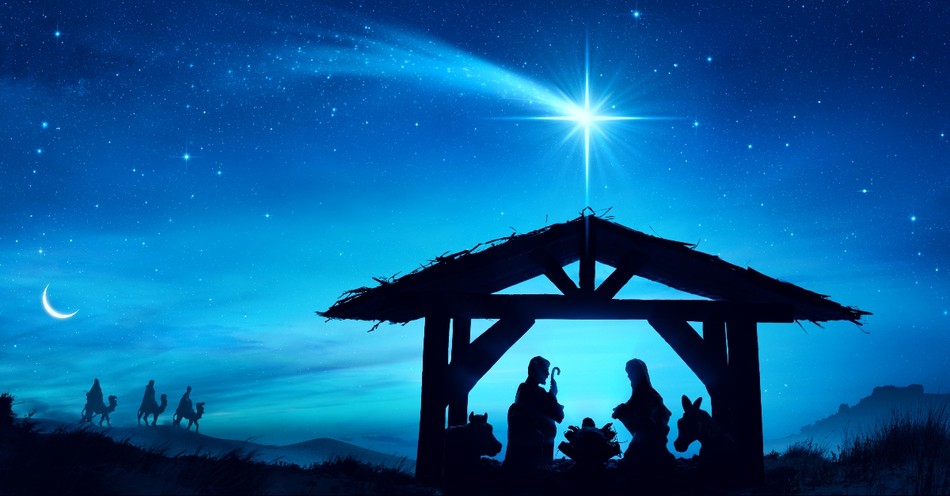Did you know the Christmas star is known as the Star of Bethlehem? Most Christians have heard that phrase but let's dive into the significance and meaning of this name!
What nativity scene is complete without a shining star at the top? The star has become a Christmas tradition, but the actual star in the Bible occupies only a brief 12 verses, leaving questions in its wake.
What was the star of Bethlehem? And what did it signify? Let's take a look at Scripture, some theories, and what the star meant back when Jesus was born and what it means for us today.
Table of Contents
- Star of Bethlehem in the Bible
- What Was the Star?
- Evidence of the Star's Appearance
- Purpose of the Star of Bethlehem
- Symbolism of the Star
- What It Means For Us
The Star of Bethlehem in the Bible
Matthew 2:1-2 (NIV) - "After Jesus was born in Bethlehem in Judea, during the time of King Herod, Magi from the east came to Jerusalem and asked, 'Where is the one who has been born king of the Jews? We saw his star when it rose and have come to worship him.'"
Matthew 2:7-10 (NIV) - "Then Herod called the Magi secretly and found out from them the exact time the star had appeared. He sent them to Bethlehem and said, 'Go and search carefully for the child. As soon as you find him, report to me, so that I too may go and worship him.' After they had heard the king, they went on their way, and the star they had seen when it rose went ahead of them until it stopped over the place where the child was. When they saw the star, they were overjoyed."
While it's mentioned a few times, the star of Bethlehem is never called by that name in the Bible. It first appears in Matthew 2:2, when the Magi (or Wise Men) from the east go to King Herod in Jerusalem, asking, “Where is the one who has been born king of the Jews? We saw his star when it rose and have come to worship him.”
The wise men conversed with a confused Herod, who knew nothing of this king, then set out once more. Matthew 2:9-10 records, After they had heard the king, they went on their way, and the star they had seen when it rose went ahead of them until it stopped over the place where the child was. When they saw the star, they were overjoyed.
What Was the Star of Bethlehem?
The star that guided the Wise Men to Jesus has been interpreted in different ways, and the original Greek word "aster," meaning "star" or "celestial body," adds to the mystery. In some contexts, "aster" is even used to refer to angels, as seen in Revelation 12:4. This opens the door to various interpretations, ranging from natural astronomical events to supernatural explanations.
Natural explanations for the star include the idea that it might have been a nova or supernova, where a star dramatically increases in brightness before fading away. Historical records suggest that such an event occurred around 5 B.C. and lasted for about 70 days. Some propose this "new star" could have been the one that the Magi followed.
Another possibility is that the star was actually a comet. In ancient times, comets were often seen as significant omens, and their movement across the sky could align with the idea of the star leading the Wise Men.
Theories also suggest that the star could have been a planetary conjunction, where two or more planets appear very close together in the sky, creating a bright "star-like" effect. For instance, a rare triple conjunction of Jupiter and Saturn occurred in 7 B.C. within the constellation Pisces, which was associated with Israel. For ancient astrologers, this alignment might have been interpreted as a sign of a royal birth, with Jupiter symbolizing kingship and Saturn representing rulers.
Others, however, believe that the star of Bethlehem was a supernatural manifestation that can’t be explained scientifically. These theories suggest the star was an angel (harkening back to the double potential meaning of “aster”), or that the star was in fact a manifestation of God’s Shekinah Glory, like the pillar of cloud and pillar of fire that led the Israelites through the desert (Exodus 13:21).
These theories are especially supported by the fact that Matthew 12:9 states that the star moved: And the star they had seen when it rose went ahead of them until it stopped over the place where the child was.
Evidence for the Star of Bethlehem
Aside from evidence found in Scripture, there is historical documentation supporting the timing and impact of the Star of Bethlehem story presented in the Bible.
Historical records indicate the existence of notable celestial events around the time of Jesus' birth. Astronomers have proposed various theories, including planetary conjunctions, comets, or supernovae, as potential candidates for the Star of Bethlehem. Some suggest that a rare conjunction of Jupiter and Saturn, known as a triple conjunction, could have created a bright and conspicuous celestial display.
Ancient astronomical software and simulations have been used to recreate the night sky as it appeared during the relevant period. These simulations support the idea that certain celestial configurations, such as planetary conjunctions, could have produced a bright light in the sky around the time of Jesus' birth.
Chinese astronomers documented a "guest star" that appeared around 5 B.C., possibly a nova or supernova, which aligns with the timeframe of Jesus' birth.
What Was the Purpose of the Star of Bethlehem?
Matthew is the only one of the four gospels that mentions the star. It doesn’t appear that it was seen or followed by any other parties besides the Wise Men. However, the star drew these unlikely men to Christ. The Greek word μαγοι (mάgoi) is translated as “wise men” or “magi” depending on the English translation. This word originally referred to a class of Persian wise men that were something like priests, interpreters of special signs, especially astrology. Eventually, the word came to be used for anyone who had supernatural knowledge or ability, or a magician. The Wise Men from the east were likely something along the lines of these Persian astrologers.
It’s possible the Magi knew something of Jewish prophecy due to the time the Jews spent in captivity in Babylon. Many Jews never returned to Judea, even after they were given leave to return. This knowledge combined with the signs the Magi saw in the heavens led them from the east to the little town of Bethlehem.
It is also unlikely that King Herod would have been made aware of Jesus’ birth if he was not approached by the Wise Men. Because of this information, Herod unwittingly set multiple prophecies into motion.
Matthew 2:3-5, 13-18 records:
When King Herod heard this he was disturbed, and all Jerusalem with him. When he had called together all the people’s chief priests and teachers of the law, he asked them where the Messiah was to be born. “In Bethlehem in Judea,” they replied, “for this is what the prophet has written…”
When [the wise men] had gone, an angel of the Lord appeared to Joseph in a dream. “Get up,” he said, “take the child and his mother and escape to Egypt. Stay there until I tell you, for Herod is going to search for the child to kill him.”
So he got up, took the child and his mother during the night and left for Egypt, where he stayed until the death of Herod. And so was fulfilled what the Lord had said through the prophet: “Out of Egypt I called my son.”
When Herod realized that he had been outwitted by the Magi, he was furious, and he gave orders to kill all the boys in Bethlehem and its vicinity who were two years old and under, in accordance with the time he had learned from the Magi. Then what was said through the prophet Jeremiah was fulfilled:
“A voice is heard in Ramah, weeping and great mourning, Rachel weeping for her children and refusing to be comforted, because they are no more.”
The star not only showed the Magi the way to Jesus but also made Herod and the chief priests aware that the Messiah had come, a far greater king than Herod.
What Did the Star of Bethlehem Signify?
The idea that important events or people were heralded by signs in the heavens was a common part of most religions at the time. Astrological events were often thought to portend the birth of great heroes or rulers. Thus, it isn’t surprising that the Magi were looking to the sky. It also makes sense that God would announce the birth of His Son in a way the Magi would understand.
But how did they come to the conclusion that the star specifically pointed to a “king of the Jews”? We can’t be certain. However, there are certain prophecies they might have read. In Numbers 24:17, Balaam prophesies, “I see him, but not now; I behold him, but not near. A star will come out of Jacob; a scepter will rise out of Israel.”
This verse is part of a prophetic utterance by the non-Israelite prophet Balaam. In this fascinating prophecy, Balaam speaks of a future figure with significant symbolic roles—a Star out of Jacob and a Scepter rising from Israel. These images are messianic in nature, pointing to the coming of a divine and royal figure. The Star and Scepter suggest both guidance and authority, indicating a leader who will emerge from the lineage of Jacob, the patriarch of the Israelites. This prophecy is particularly noteworthy for its dual emphasis on celestial and earthly symbolism, capturing the grandeur and majesty of the awaited figure who will possess both heavenly significance and earthly dominion.
It is also possible that they read the prophecies of Daniel, which, especially in Daniel 9, pointed to a timeline for the coming of the Messiah. Nevertheless, the star was then associated with kingship, the Messiah, and the Jews. With this information, the Wise Men went to Jerusalem, the capital of Judea, in search of the king.
What Does the Star of Bethlehem Mean for Us?
The star reminds us of Jesus’ birth, of His kingship, of His divine nature. However, the star also reminds us of something we may gloss over in the Christmas story. Jesus’ birth wasn’t announced to those we would have expected. The host of angels didn’t come to the head priests or the leaders of the Jews; they appeared to lowly shepherds (Luke 2:8-20).
Likewise, the star didn’t appear to the scholars and scribes of Jerusalem. Instead, it was shown to Gentile magi, outsiders who would have been scorned by devout Jews as pagans. The star reminds us that the gospel isn’t just for the religious, for the neat and tidy. It’s for not only the poor shepherds of society but also the astrologers of this world, those foreign to us.
The Father announced His Son’s birth to the most unlikely candidates, showing His love for all of humanity, His desire for all to know Him. The gospel is for everyone, and we have the honor, the joy, and the sacred duty to share it.
Photo Credit: ©iStock/Getty Images Plus/RomoloTavani




